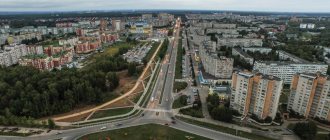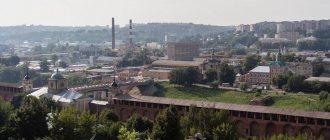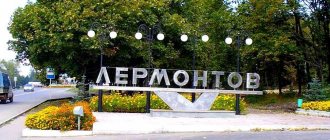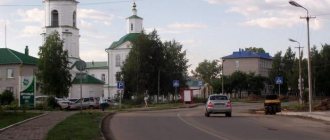People often ask the question: what federal district is Omsk? Or they ask differently. What federal district is Omsk? But in fact, Omsk is one of the cities in the Siberian part of Russia. It is located on the West Siberian Plain, as part of the Siberian Federal District. Omsk is one of the largest cities in Russia and Siberia. It is the administrative center of the Omsk region. It ranks eighth in the country in terms of population. The area of this city is 567 square meters. km. In total, it includes 5 administrative districts. The size of the city is about 40 km. Population: 1,166,092 people. The population density is 2.05 thousand people/km2. Which federal district does Omsk belong to? Now Omsk is part of the Siberian Federal District.
The famous Trans-Siberian railway passes through Omsk.
Geography and natural conditions.
Also on topic:
RUSSIA (RUSSIAN FEDERATION, RF)
Omsk is located in the Omsk Irtysh region, which is a relatively flat surface with prevailing altitudes of 100–140 m above sea level. The monotonous relief in some areas is disturbed by depressions of flat depressions, ancient runoff hollows, lake basins, ridges and ridges .
The flatness of the territory is due to the peculiarities of the geological structure of the West Siberian Plain, at the base of which, at depths from several hundred meters to four kilometers or more, lies a foundation composed of ancient igneous (granites, diabases) and overlying metamorphic (gneisses, schists) strata, crushed into folds and broken into blocks by tectonic faults.
The climate of Omsk is continental, much more severe than in other places corresponding to its latitude. The average temperature of the warmest month, July, is +17° C, the coldest month, January, is about –20° C. However, in terms of the number of hours of sunshine, Omsk surpasses not only Moscow, Sverdlovsk, but also Batumi, Kharkov, second only to Yalta and Krasnodar. The average day length in June in Crimea is 15.5 hours, and in Omsk - 17.2 hours. The predominant wind direction in winter is south-west, in summer - north-west. The highest wind speeds are observed in winter and spring, which causes frequent snowstorms and dust storms.
City population
The population of Omsk began to grow rapidly from about 1900 and increased until the 90s of the 20th century, after which it remained without pronounced dynamics. In 1903 it was only 60 thousand people. The maximum number was recorded in 2017 – 1,178,391 people. This is eighth place among other Russian cities. Most of the residents of the Omsk region (60%) live in Omsk. A significant part of the population arrives in the city from other points of the Omsk region and CIS countries. But there are also positive changes in the birth rate and reduction in mortality in the city itself.
The elderly population in Omsk is 20 percent. The average life expectancy of men is short - only 63 years. While women live on average 75.6 years. There are more women in Omsk than men – 55%.
Story.
The territory of Western Siberia has been inhabited since ancient times. The first known human settlements in the Omsk region date back to the 12th–11th millennium BC. On the right bank of the Irtysh, in the Omsk region and in the Barabinsk steppe, burial mounds dating back to the end of the 1st millennium BC, as well as settlements of settled populations, were discovered. The culture of the then inhabitants of the region was close to the Altai. In the 6th century. BC. – 4th century AD Ugric tribes lived in the region - the ancestors of modern Hungarians. In subsequent centuries, the Ancient Kyrgyz Khanate and the Turkic Khaganate existed in the steppe region, and the population underwent active Turkization. In the 13th century The Irtysh region was conquered by the Mongols and included in the Golden Horde. Turkic-speaking Siberian Tatars settled in the area and later converted to Islam. After the collapse of the Horde in the 15th century. The Siberian Khanate was formed in Western Siberia. Following Ermak's campaign in 1581–1585, it was at the beginning of the 17th century. conquered by the Russian state, and the settlement of Siberia by settlers from European Russia began; The cities of Tyumen (1586), Tobolsk (1587), Tara (1594), Obdorsk, now Salekhard (1595), Tomsk (1604) arose.
Taking care of strengthening the security of the southern borders of Siberia, which passed in the 17th century. in the area of modern Omsk, Tara governors Yuri Shekhovsky and Mikhail Kaisarov in 1628 sent a petition to the tsar asking for permission to build a new fortress at the confluence of the Irtysh and Om rivers. The immediate founder of the Omsk fortress in 1716 was an expeditionary detachment under the command of Lieutenant Colonel Ivan Dmitrievich Buholts. The detachment was sent by Peter I to Siberia to build new fortresses and search for trade routes to China and India. The first wooden Omsk fortress, built on the left bank of the Om, lasted a little over 50 years. In 1768–1771, on the initiative of the commander of the Siberian Corps, General I.I. Springer, a new fortress was built on the right bank of the Om. It occupied a significantly larger area and had more advanced protective engineering structures.
In 1782, the Omsk fortress received the status of a provincial military district city of the Tobolsk governorship (until 1797), in 1804–1822 Omsk was part of the Tobolsk province, and in 1822–1839 it was the center of the Omsk region. In 1824 the city became the capital of the West Siberian General Government (until 1882). Omsk was also the administrative center of the Siberian Cossack Army (1808–1917).
Omsk Fortress - place of imprisonment. In the first half of the 19th century. it housed a convict prison in which the Petrashevites F.M. Dostoevsky and S.F. Durov were serving their sentences. Based on personal impressions from the Omsk penal servitude of F.M. Dostoevsky wrote Notes from a Dead House
.
In 1882, Omsk became the center of the newly formed Steppe Governor-General, which included areas of the south of Western Siberia and part of modern Kazakhstan.
Intensive economic development of the city began at the end of the 19th century. In 1894–1895, the Siberian Railway connected Omsk with Chelyabinsk, and in 1913 a railway line to Tyumen was built. The road contributed to the rapid settlement of the southern part of Western Siberia. The rapid development of trade began. At the beginning of the 20th century. Omsk became a trading center of Western Siberia (export of agricultural products, especially butter, grain, fish, furs and fur products, leather) with a poorly developed industry.
During the revolution and civil war in Russia, Omsk repeatedly changed hands. In October (November) 1917 the local Council announced the seizure of power into its own hands. The Junker uprising was suppressed. The establishment of Soviet power in Western Siberia was confirmed in December 1917 by the regional congress of Soviets of Workers' and Soldiers' Deputies in Omsk. But already on June 8, 1918 the city was occupied by troops of the Czechoslovak corps. It housed the West Siberian Commissariat, which was dominated by the Socialist Revolutionaries. Later, Omsk came under the authority of the Provisional Siberian Government, in October the Ufa Directory moved to Omsk, and after the coup of Admiral A.V. Kolchak, who was proclaimed the supreme ruler of the Russian state in November 1918, the city became the capital of the Russian “white” movement. In November 1919, Omsk was occupied by the Red Army. At the beginning of 1921, the Omsk province became one of the centers of the West Siberian peasant uprising, suppressed by the Bolshevik government.
Until 1921 Sibrevkom was located in Omsk. In 1925–1930, Omsk was a district city and regional center of the Siberian (from 1930 – West Siberian) region, and from 1934 – a regional center of the newly formed Omsk region.
In the 1920s–1930s, Omsk remained the most important hub of the agrarian-industrial complex of Siberia, new production of agricultural and transport equipment was developed there, and a higher school was created. The population of the city grew rapidly: in 1926 there were 162 thousand inhabitants, in 1939 - already 281 thousand. During the Second World War 1941–1945, more than 150 industrial enterprises of metalworking, food, leather, textile, chemical and other industries. Due to the large number of military-industrial complex enterprises, Omsk was a “closed” city until the mid-1990s.
Since the mid-1950s, Omsk has become the center of the oil refining and petrochemical industries of Siberia. A large oil refinery began processing oil from the Middle Ob region, from where regular transportation along the Ob and Irtysh to Omsk began in 1965. Since 1967, oil began to be delivered via the Ust-Balyk – Omsk oil pipeline (1036 km). By 1970, the city's population had grown to 821 thousand. In the 1970–1980s, the development of industrial and housing construction determined the growth in production volumes of the building materials industry.
Since the early 1990s, a non-state sector began to form in the city’s economy. Private enterprises, banks, financial and investment companies, funds, etc. were formed. Since 2001, oil development of the Krapivinskoye field in the north of the Omsk region began. Since 2002, Krapivinsk oil began to flow to Omsk. The chemical industry is represented by the production of tires, synthetic rubber, carbon black and rubber products, etc. Joint-stock enterprises and companies in the woodworking, television, radio and gas equipment, construction industries, textile, footwear, clothing, furniture, food (meat-processing, flour-mill) enterprises and etc.
General characteristics.
The economy of Omsk is based on the natural resources of the region - numerous deposits of various types of clays and loams, construction sands, peat and marls. Sapropel is found in a number of lakes. In the depths of the region there are deposits of oil and gas, iron ore, zircon-ilmenite placers and groundwater. There are several aquifers that are a source of water supply. Groundwater is widely used for medicinal purposes. The undoubted advantages of Omsk are its convenient geographical location, the presence of qualified personnel, a developed system of market institutions, political stability, active participation in the economic, scientific and cultural life of Russia.
The average number of employees at large and medium-sized enterprises and organizations in Omsk was estimated in June 2004 at 342.5 thousand people, the average monthly accrued wages in nominal terms was 7,090 rubles. The number of officially registered unemployed people was 2,719 people.
[edit] Mineral resources
Omsk is located in the southwestern part of the West Siberian Plain, geologically in the southwestern part of the West Siberian Plate. The enormous thickness of the cover sediments accumulated on the West Siberian Plain determines the presence of sedimentary mineral reserves in the territory.[40]
On the territory of the urban district there are deposits of loam and construction sand. Clay rocks form the basis of the region's raw material base for the production of building materials.[41]
The following deposits have been explored on the territory of the city of Omsk:[42]
- Eastern loam deposit (brick raw materials);
- Omsk 2 loam deposit (brick raw materials);
- “Eastern section of the Omsk-1 deposit” of loam (brick raw materials);
- Quarry deposit of loam (expanded clay raw materials);
- Rostov loam deposit (brick raw materials);
- Stepnoe loam deposit (expanded clay raw material);
- Ulyanovsk loam deposit (brick raw materials);
- “Deposit of the Brick Factory No. 2” loam deposit (brick raw materials);
- “Omsk rubber” loam deposit (brick raw materials);
- Chukreevskoe loam deposit (expanded clay raw material);
- Andreevskoe loam deposit (brick raw materials);
- "Neftyanik" deposit of loams and construction sands;
- Novoaleksandrovskoe loam deposit (raw material for construction purposes).
[edit] Brick loams
The main raw materials for the manufacture of brick and tile products are upper Quaternary cover clays and loams, which lie in a continuous cover 2-8 m thick on interfluves and river terraces. Less commonly, clayey rocks that participate in the structure of the river terraces themselves and clayey deposits of the Kochkovo formation are used to make bricks.[43]
In terms of reserves, the bulk of explored deposits are classified as small (less than 5 million tons).[44]
“The Kirpichny deposits are partly in the distributed fund, partly in the state reserve.[45]
Loam deposits of brick raw materials meet the requirements of GOST 530-2012 “Ceramic brick and stone. General technical conditions" and are suitable for the manufacture of bricks of grade "100" and higher.[46]
[edit] Expanded clay
The raw materials for the production of expanded clay gravel are clay fusible rocks, which, when quickly fired, swell, forming a lightweight material with a cellular structure; In the absence of natural gravel in the area, expanded clay is an indispensable building material, which is used as fillers in the manufacture of thermal insulation and structural lightweight concrete. For the production of expanded clay, mainly ubiquitous cover clays and loams of late Pleistocene - Holocene age, as well as middle-upper Miocene clays, are used. The deposits have a sheet-like shape with a thickness of 2-12 m.[47]
In its natural state, clay raw materials usually do not swell or swell when melted. To increase the swelling ability, organic and organomineral additives (fuel oil, etc.) are used.[48]
Clay (expanded clay) raw materials are suitable for the production of expanded clay gravel grades from M500 to M800.[49]
[edit] Construction sands
Deposits with industrial reserves of construction sands that meet the requirements of standards for construction work are mainly confined to the river bed. Irtysh. The sands of floodplain deposits are characterized by lower quality and greater thickness of overburden. The quality of construction sands from floodplain deposits meets the requirements of SN-449-72 “Instructions for the design of the subgrade of railways and highways”, SP 34.13330.2012 “Highways” and GOST 8736-2014 “Sand for construction work. Technical specifications.”[50]
Industry.
In the first half of 2004, the volume of industrial production (excluding small businesses) reached 24 million 842.2 rubles, which meant an increase of 8.7% compared to the same period in 2003. The structure of industrial production is dominated by the electric power and fuel industries (38, 2%), food (23.6%), chemical and petrochemical (18.7%), mechanical engineering and metalworking (13.4%), production of building materials (2.6%). The rest comes from forestry, woodworking, pulp and paper, light and other industries.
Transport.
Omsk is an important transport center, located at the intersection of the Trans-Siberian Railway with a large water artery - the Irtysh River. There is an airport.
The total transport freight turnover for the first half of 2004 amounted to 56.983 million tons km. (growth by 13% compared to the previous period last year): incl. railway 35.661 million t.km.; automobile 163 million t.km.; air 0.7 million t.km; pipeline 20.707 million t.km.; inland water 451 million t.km.
The length of the route network of the city's municipal transport as of May 1, 2003 was 2984 km and included: 140 bus routes with a length of 2709 km, 13 trolleybus routes with a length of 212 km, 6 tram routes with a length of 64 km. and 11 municipal minibus routes. 846 buses, 207 trolleybuses, 118 trams, 132 small-capacity municipal buses and 1,854 small-capacity buses for individual entrepreneurs are used to serve the population. Every day, 0.8 million passengers are transported along the city's routes.
Ecological situation
Until recently, industry was the main source of urban air pollution. The most disadvantaged was the Sovetsky district, where the largest number of enterprises were located. Now the most significant pollutant is motor transport. Now the most polluted are the Central and Kirov districts, where the number of cars is maximum. In general, the environmental situation has become much better over the past 10 years. However, the problem of landfills and river pollution still remains acute.
Planning and architecture.
Some important historical and architectural monuments have been preserved from pre-revolutionary Omsk. Its oldest building is the guardhouse building built in 1781–1783 (Partizanskaya St., 14), which currently houses the regional military registration and enlistment office. The oldest buildings in Omsk include the Tobolsk Gate (on the Tukhachevsky embankment), the only one of the four gates that led to the Omsk fortress. Through them, convicts went to work on timber rafting. Was among the prisoners in the 19th century. and the great Russian writer F. Dostoevsky. Another gate - Tara - was restored in 1991 on the old foundation.
The house of the commandant of the Omsk fortress, where Dostoevsky visited (now a literary museum), has been preserved.
In the historical center of the city there is the building of the former Governor General's Palace, the construction of which was carried out under the leadership of the architect F.F. Wagner and engineer K.E. Lazarev and was completed in 1862. The walls of the building, in front of which one of the first gardens in the city was laid out, witnessed the most important events that took place in Omsk in the second half of the 19th and early 20th centuries. They remember outstanding statesmen, world-famous travelers and explorers of Siberia, and cultural figures. The building housed the Governors General of Omsk and the Steppe Territory, successively housing the Council in 1917, the West Siberian Commissariat and the Provisional Siberian Government in 1918, the government of Admiral Kolchak in 1918–1919 and, finally, the headquarters of the 5th Red Army under the command of M.N. Tukhachevsky , which occupied Omsk in November 1919. In April 1925 it was transferred to the West Siberian Regional Museum. The palace has largely retained its original architectural appearance. Since 1985 it has housed the Museum of Fine Arts. M. Vrubel.
An architectural monument built in the Siberian Baroque style is the building of the Omsk Academic Drama Theater, commissioned by the city authorities by the architect I.G. Khvorinov (1901–1905). It has become one of the calling cards of the city.
The building of the former cinema "Khudozhestvenny" (until 1930 - "Pallas Crystal") was built in 1916. In the late 1990s, it underwent a major reconstruction, and now it houses an organ hall.
Among other buildings of the pre-revolutionary period: the Legislative Assembly (1914–1917, architect V.A. Prusakov); a complex of commercial buildings, the so-called “Moscow Trading Rows”, built in 1905 by the architect O. Dessin by order of the largest Russian manufacturers Morozov, Ryabushinsky, Tsindel, Mamontov; St. Nicholas Cossack Cathedral (1833–1840), built according to the drawings of the famous Russian architect V.P. Stasov. 28 residential buildings in Omsk with original carved platbands, cornices, pediments and entrance porches are registered as monuments of wooden architecture. It was decided to preserve individual details (platbands, cornices, entrance doors, entrance porch brackets) of 26 houses.
In the years after World War II, Omsk significantly changed its former appearance. Now it is defined by wide highways, landscaped embankments, powerful arcs of bridges connecting the banks of the Irtysh and Om, tall tower houses, and large industrial complexes. Among the monuments of the 20th century: the Palace of Culture of Oil Workers (1960–1962, architect M.A. Miskevich, G.G. Protopopov), River Station (1961–1963, architect S.A. Mikhailov, T.P. Sadovsky and others. ); Cinema and Concert Hall (architect A.M. Karimov, A.I. Yumakaev), Theater for Young Spectators (architect V.N. Belousov; both - 1965–1967, Musical Theater, built in 1981. Its original architectural solution was proposed by a group of architects including D.E. Lurie, N.N. Stuzhin, N.N. Belousova, engineers V.A. Visloguzov and Yu.I. Fridman. Noteworthy is the construction of the Shopping Center, erected at the intersection of two main highways of the city, on the site of the old market ( in 1986, its authors, designers and constructors, as well as the builder P. Kucher, were awarded the State Prize of the RSFSR).In 1995, the city's first color-musical fountain was opened on Teatralnaya Square. Also interesting is the building of the State Scientific Library named after A.S. Pushkin with a 14-story book depository. The façade is decorated with figures of Russian enlighteners and reliefs. History of culture
(author sculptor V.A. Trokhimchuk). The building was designed by a large creative team consisting of G.N. Naritsyna, T.L. Moroz, Yu.A. Zakharov and engineer I.N. Lyubich.
Until 1973, the development of Omsk was concentrated on the right bank of the Irtysh. One of the objectives of the 1970 master plan was the construction of residential and industrial buildings on the left bank. Now Left Bank is one of the vast residential areas. It was conceived as an environmentally friendly zone, free from industrial enterprises. Active construction continues here today, but the standard panel houses of the 1970s and 1980s are being replaced by luxury houses. On the left bank there are two large hospital complexes - an emergency hospital and a multidisciplinary clinical hospital. Already in the 21st century. the Church of the Nativity of Christ was built on the Left Bank (architect A. Slinkin).
Education.
At the beginning of the 2002/2003 academic year, there were 206 daytime educational institutions in Omsk (195 state and 11 non-state). The number of students was 136.6 thousand people.
There are 20 higher education institutions in Omsk (10 state and 10 non-state, licensed by the Russian Ministry of Education). The oldest is Omsk State Agrarian University (formerly Siberian Agricultural Academy, 1918). Omsk State University, Pedagogical Polytechnic, Transport Universities, academies: medical, railway and road transport, physical education are widely known. A number of military higher educational institutions train personnel for the army and internal affairs bodies. The oldest military educational institution in Omsk, founded in 1813, is the Siberian Omsk Cadet Corps. At different times, it was completed by the founder of Siberian regionalism G.N. Potanin, the Kazakh scientist and educator Chokan Valikhanov, the publicist and poet I.F. Annensky, the historian of the Siberian Cossack army G.E. Katanaev, the leader of the white movement L.G. Kornilov, Bolshevik leader statesman V.V. Kuibyshev (born in Omsk in 1856), Hero of the Soviet Union General D.M. Karbyshev, etc. By the beginning of the 2002/2003 academic year, 78.6 thousand people were studying in state institutions of higher education .
38.7 thousand people studied in 34 institutions of secondary vocational education. The number of students who received secondary (complete) general education in 2002 was 11.9 thousand people. 17.7 thousand boys and girls received certificates of basic general education.
At the end of 2002, there were 194 preschool educational institutions in Omsk; the number of children in them amounted to 27.8 thousand people.
The science.
Omsk is an important scientific center in the field of automation, technology, design, metallurgy, medicine, auto repair, radio engineering, construction, etc. In the city there are the Russian NPO "Mir", scientific and technical, association "Industrial Automation Systems", LLC NPP "Metromed", NPP "Civic", Omsk State Institute of Systems Engineering, LLC NPO "Montessori", NPO "Promekologiya", Department of the Chief Welder PRP AK "Omskenergo", Omsk Research Institute of Instrument Engineering, Cadastral, Center for Humanitarian, Socio-Economic and Political Research, "Omsktransproekt", etc.
Culture.
The theatrical tradition in Omsk dates back to the private theater created in the Omsk fortress in 1764 by order of the commander of the Siberian Corps, Lieutenant General I. I. Springer. In the middle of the 19th century. amateur performances were staged in the Siberian Cadet Corps, and they were also held in the prison camp (F.M. Dostoevsky took part in the preparation of one of them).
Currently, there are 7 theaters in Omsk: Academic Drama Theater, Omsk State Puppet Theater, Omsk State Musical Theater, Omsk Theater for Children and Youth, Omsk State Chamber “Fifth Theater”, City Drama and Comedy Theater “Galerka”, Lyceum Theater and “Studio” by L. Ermolaeva. Omsk Academic Drama Theater, which is one of the most powerful theater groups in the country. During the Second World War, the theater named after Omsk, evacuated from Moscow, worked on the stage of the Omsk theater. E. Vakhtangov. The creative career of many popular actors began in Omsk: M. Ulyanov, S. Mishulin, V. Dvorzhetsky; The stars of today's TV series, Yu. Kuznetsov and N. Chindyaykin, worked in the theater for many years, and S. Chonishvili began his acting career.
In 1983, a hall of organ and chamber music was opened in Omsk. It contained an organ made in Czechoslovakia and considered one of the best in Russia. All the leading organists of the country played on it, concerts were given by such artists as organist Harry Grotberg, Oleg Yanchenko, soloists Dmitry Hvorostovsky, etc. In 1990, the building of St. Nicholas Cossack Cathedral, which housed the organ, was transferred to the diocese and in 1998 the organ was The reconstructed building of the Khudozhestvenny cinema was moved. A new organ hall was opened there in 2002.
In Omsk today there are 6 state and more than 20 departmental museums. One of the oldest and largest in Siberia is the Omsk State Museum of History and Local Lore, founded in 1878 as the museum of the West Siberian department of the Imperial Russian Geographical Society. At its origins were such outstanding scientists as M.V. Pevtsov, I.F. Bobkov, I.Ya. Slovtsov, G.E. Katanaev, G.N. Potanin, N.M. Yadrintsev and others. It contains materials from numerous scientific expeditions, collections brought from China, central Asia and India, collections of butterflies, stuffed animals, minerals, objects from archaeological excavations, rare exhibits from the history of the region, its nature and culture (clothing, household utensils, collections of early printed books, memorabilia medals, gold and silver coins). Among the unique exhibits is the banner of the Siberian Cossack Army of 1690.
In 1856, M.A. Vrubel was born in Omsk. The regional museum of fine arts, the largest art collection in Siberia, is named after him. It houses collections of foreign and Russian art from antiquity to the present day. Works of outstanding Russians (I. Repin, V. Serov, M. Shishkin, V. Surikov, I. Levitan, V. Vasnetsov, M. Vrubel, N. Goncharova, M. Larionov, V. Kandinsky, A. Yavlensky, representatives of the association “Jack of Diamonds”, etc.) and Western European artists, sculpture, original graphics, engravings, palace furniture, porcelain, glass, rare printed publications. In terms of the number of art galleries, Omsk is a leader among cities in the Asian part of Russia. Among the Omsk galleries: the exhibition hall of the Omsk Union of Artists; gallery-studio “Golden Path”, which operates in the foyer of the Chamber Stage named after. T. Ozhigova of the Omsk Academic Theater; "The World of Painting"; exhibition and sales galleries “Yes-Yes” and “Square”; gallery "Staircase", "D'Art", "Two ELs", "Przhevalsky's Horse", salon - exhibition "Christo". There is also a Literary Museum named after. F.M. Dostoevsky, Museum of Military Glory of Omsk and others. In 1991, the only state museum in Russia focused on local culture was opened - the Art of Omsk Museum, which collects and stores works of art of different genres and styles created by local artists.
Popular message topics
- Pension Fund
The Pension Fund (PF) is the largest government structure dealing with social payments to the population. The pension fund was created in 1990. Its main tasks were the collection of insurance contributions, - Strawberry
is a plant with properties similar to strawberries. Strawberries grow mainly in forests. Belongs to the Rosaceae family. Translated from Latin, the word “strawberry” means “fragrant.” That's what they called her because - City of Odessa
The city - the hero of Odessa has many names. Southern capital, Pearl by the sea, Odessa - mother, and all these poetic names belong to Odessa. This is a truly unique city. There is an excellent maritime climate, the steppe borders the sea
Sport.
Omsk has been a sports center in Western Siberia since pre-revolutionary times. Currently, the city has 8 large stadiums (with stands over 1,500 seats), 2 athletics arenas, 51 swimming pools, 354 gyms, 46 ski resorts, 49 shooting ranges, 51 swimming pools, 354 gyms, 46 ski lodges, 49 shooting ranges, 51 sports and recreation centers at enterprises, firms and institutions, a yacht club for 150 ships, a unique recreation and sports area “Green Island”. The Irtysh sports and concert complex is the best such facility in Siberia and the Far East. In recent years, Omsk has become the venue for Russian championships in Greco-Roman wrestling, sambo, triathlon, swimming, rinkball, and rhythmic gymnastics. The Siberian International Marathon is organized annually. In 1950, the Institute of Physical Culture was opened in Omsk, now the Siberian State Academy of Physical Culture. Many Omsk athletes became world and Olympic champions and record holders.
Vadim Damier
Omsk Airport
In Omsk there is an international airport of category “B” Omsk-Tsentralny, which was opened on May 17, 1929. The airport building is located 5 km from the city center. You can get to the airport by car and public transport (minibuses, buses).
The airport serves 19 airlines - both Russian and international. The most popular destinations: Surgut, Khanty-Mansiysk, Samara, Novosibirsk, Yekaterinburg, Moscow, Kazan, Astana (Nur-Sultan), Tomsk, Ufa. The airport's passenger traffic is up to 2 million passengers per year.
Luggage packing services are provided by. The point where packaging is carried out is located on the first floor of the main building of the Omsk-Tsentralny airport. There is also a 24-hour VIP lounge in the airport building. In addition to passenger aircraft, aircraft of the Ministry of Internal Affairs of the Russian Federation are based at the airport, since Omsk-Tsentralny is a joint airfield. In the ranking of the best airports for the transportation of passengers, mail, and cargo, Omsk-Tsentralny is among the 30 best airfields in Russia.










